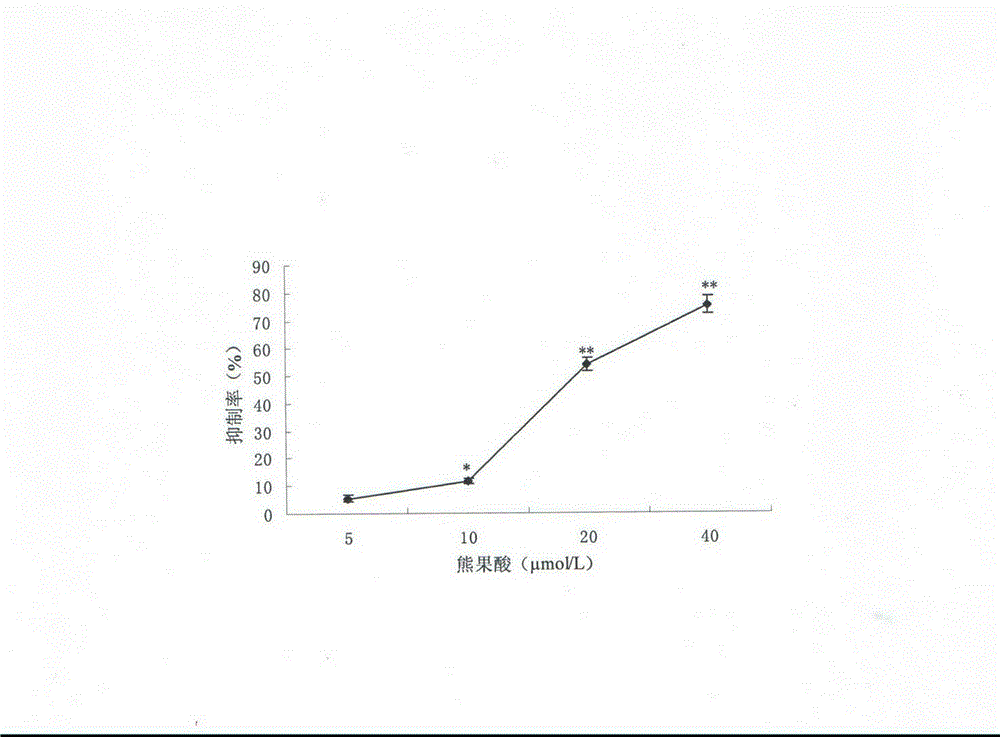Application of ursolic acid to antitumor immunity
A technology of anti-tumor immunity and ursolic acid
- Summary
- Abstract
- Description
- Claims
- Application Information
AI Technical Summary
Problems solved by technology
Method used
Image
Examples
Embodiment 1
[0022] The influence of embodiment 1 ursolic acid on H22 cell proliferation inhibition:
[0023] (1) H22 cells were grown to the logarithmic phase, and 2.0×10 4 Individual / mL single cell suspension, 180 μL / well was inserted into a 96-well culture plate and cultured overnight;
[0024] (2) Add 20 μL of different concentrations of UA to each well, the final concentrations are 0 (control group), 5, 10, 20, 40 μmol / L (medication group), and each concentration is replicated in 3 wells, cultured for 48 hours;
[0025] (3) Add 20 μL / well of MTT with a concentration of 5 mg / mL and place in CO 2 After continuing to culture in the incubator for 4 hours, discard the supernatant in the wells of the culture plate, add 150 μL of DMSO to each well, shake well to fully dissolve the blue-purple precipitate;
[0026] (4) Measure the absorbance A value at 570nm with a microplate reader, calculate the cell growth inhibition rate, and use the Bliss method to obtain the half inhibitory concentrat...
Embodiment 2
[0029] Example 2 The effect of ursolic acid on inducing the apoptosis of mouse hepatoma cell H22 cells:
[0030] (1) Cells in logarithmic growth phase 0.8×10 6 inoculated in 100mm cell culture dish overnight;
[0031] (2) Add 20 μmol / L ursolic acid to act for 24 hours and 48 hours respectively. After trypsinization, collect the cells, wash twice with pre-cooled PBS, and wash with 1.0×10 6 Cells per mL were resuspended in 500 μL of 1× binding buffer, and 5 μL of Annexin V-fluorescein isothiocyanate (Annexin V-FITC) and 10 μL of propidium iodide (PI) dye were added , mix gently, and react at room temperature for 15 minutes in the dark;
[0032] (3) Cell apoptosis rate was measured by flow cytometry, and the experiment was repeated three times;
[0033] (4) The results showed that ursolic acid could induce H22 tumor cell apoptosis in a time-dependent manner ( figure 2 ).
Embodiment 3
[0034] Embodiment 3 ursolic acid is to the growth inhibitory action of H22 mouse xenograft tumor:
[0035] (1) Centrifuge H22 cells in the logarithmic growth phase at 1000r / min for 5min, wash the cell pellet with saline three times, discard the supernatant, resuspend in PBS, and count the viable cell rate by staining with 0.2% trypan blue. When the viable cell rate is >95% , adjust the number of cells to 1×10 7 Each / ml, 0.2ml was inoculated in the abdominal cavity of mice;
[0036] (2) Randomly select 50 healthy Kunming female mice, absorb H22 cells that have been passaged in the mice for 7-10 days under sterile conditions, and adjust the cell density to 1×10 with normal saline. 7 Each / ml, inoculate 0.2ml subcutaneously in the armpit of the left forelimb of the mouse;
[0037](3) After modeling, according to the weight of the mice, the mice were randomly grouped into blocks and divided into 5 groups, with 10 mice in each group, which were high (40mg / kg.d), medium (20mg / kg.d)...
PUM
 Login to View More
Login to View More Abstract
Description
Claims
Application Information
 Login to View More
Login to View More - R&D
- Intellectual Property
- Life Sciences
- Materials
- Tech Scout
- Unparalleled Data Quality
- Higher Quality Content
- 60% Fewer Hallucinations
Browse by: Latest US Patents, China's latest patents, Technical Efficacy Thesaurus, Application Domain, Technology Topic, Popular Technical Reports.
© 2025 PatSnap. All rights reserved.Legal|Privacy policy|Modern Slavery Act Transparency Statement|Sitemap|About US| Contact US: help@patsnap.com



